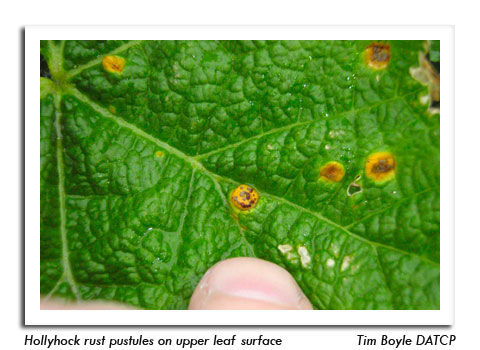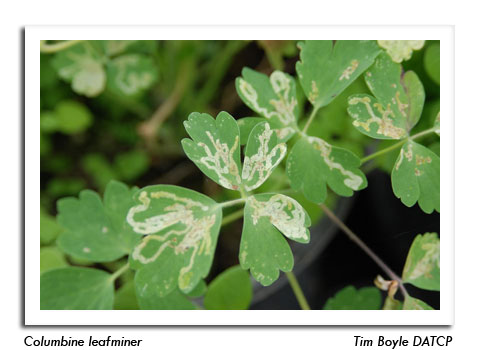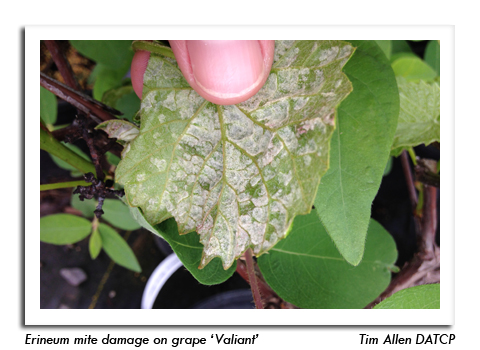
 |
|
|
Nursery & Forest
Volume 59 Number 7 Date 06/12/2014 HOLLYHOCK RUST - Nursery inspectors observed this rust disease on hollyhock 'Chater's Double Mix' and mallow 'Zebrina' at a garden center in Washington County. Symptoms include numerous light yellow spots on the upper leaf surfaces and orange-brown rust pustules on the leaf undersides. Hollyhock rust worsens throughout summer, killing most of the foliage on infected plants by early fall. Disease spread occurs by windborne spores, splashing water or infected transplants and is favored during periods of warm, humid weather. The disease cycle can be broken by cutting stalks back to ground-level in fall and destroying all infected plant material. COLUMBINE LEAFMINER - Leaf mines caused by the larval stages of this insect were noted this week on columbine at a nursery in Barron County. The serpentine mines are formed as the larvae eat their way through the leaf tissue and initially appear whitish in color, eventually turning tan or brown later in the season. Removing and destroying infested leaves in the fall will reduce this aesthetic problem. BROAD MITES - Mite infestations were found on Impatiens 'Spellbound Pink Splash' and 'Spellbound Royal Purple' and wishbone flower 'Rose Moon' and 'Yellow Moon', in a Dodge County greenhouse. The toxic saliva produced by these tiny (0.3 mm) mites results in curling, hardening and twisting at growing points of the plant, symptoms similar to herbicide damage. Broad mites are best managed by isolating and treating infested plants with an appropriate miticide. LEAF BLISTER MITES - Bartlett pear trees at a nursery in Dodge County were exhibiting foliage with leaf blisters caused by this mite pest of apples and pears. Blister mites overwinter as mature females at the bases of buds or under the bud scales and oviposit on developing leaf tissue in spring. Feeding by the adult females and their offspring results in the formation of light green blisters on new growth, which eventually turn brown as the leaf tissue dies. Blister mites also attack the fruits, causing scarring that renders fruits unmarketable. For severe problems, these arthropods can be controlled with a fall miticide application directed against adult female mites as they migrate from the blisters to the terminal buds to overwinter. -- Ellen Hermanson, DATCP Nursery Inspector ERINEUM MITES - Grape vines (Valiant variety) infested by these microscopic mites were found last week in Sawyer County. Erineum mites are just 0.2 mm in size and require high magnification to observe. They form hemispherical galls on the underside of leaves that initially have a velvety-white appearance due to a multitude of dense, long leaf hairs. Opposite the galls are conspicuous bumps on the leaf surface. Adult mites overwinter under bud scales and move in the spring to new shoots. They can produce multiple generations per year. Damage to mature vines is rare unless all leaves are heavily infested or other stresses combine with mite feeding to put a greater strain on the plant. Removing galled leaves can control light infestations. Heavier infestations may require chemical or biological control treatments. -- Tim Allen, DATCP Nursery Inspector GYPSY MOTH - As of June 10, all Btk and Gypchek applications were completed in Wisconsin, marking the conclusion of the first phase of the 2014 treatment season. Counties receiving Btk treatments were: Barron, Bayfield, Douglas, Dunn, Eau Claire, Grant, Green, Jackson, La Crosse, Lafayette, Polk, Richland, Rusk, Sawyer and Trempealeau. Thirty-one sites totaling just over 17,600 acres were treated with Btk, most of which received two applications. Eight sites in Eau Claire County totaling about 3,600 acres were treated with Gypchek. The first phase of the program targeted gypsy moth larvae; the second phase, which utilizes a pheromone mating disruptor, will target the gypsy moth in its adult stage. Mating disruption treatments should begin in late June or early July. The annual moth trapping survey continued, with 7,458 traps set, just over 56% of the estimated total, as of June 11. All pheromone traps intended for Columbia, Jefferson, Marathon, Oneida, Richland, Waukesha and Wood counties, and the Port of Superior, have been set. The remaining 44% of traps are expected to be in place by the first week of July to catch the earliest emerging moths. -- Rick Hummell, DATCP Gypsy Moth Program 





|
|
|